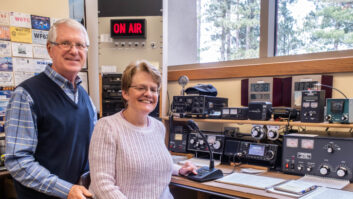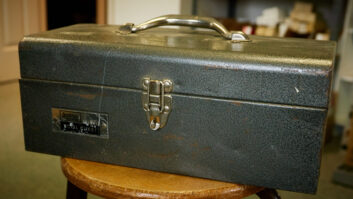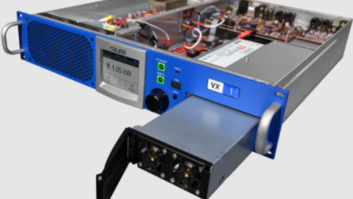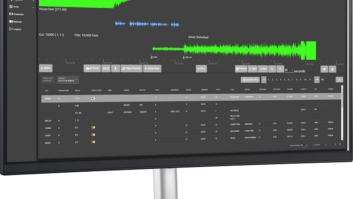(click thumbnail)Fig. 1: A nice cap with a broad bill keeps the sun out of your eyes.Sunbury Broadcasting Chief Engineer Harry Bingaman always gets his brother a funny present for Christmas. The rules are it has to be funny but also practical.
One weekend Harry was surfing the L.L. Bean site and found the hat shown in Fig. 1. He called it to my attention; my reaction was, “That’s a nice hat, but no big deal.”
Then Harry showed me Fig. 2. The brim has two ultra-bright LEDs sewn inside that run off a small battery cell in the adjustment band in the back. Now he had my attention!
He ordered the hat and Harry saw a million uses for it, like finding the keyhole in a lock on the transmitter site gate; illuminating the combination lock at the fence surrounding the base of the tower; as a replacement trouble lamp when you are looking inside the back of a dark equipment rack; and negotiating your way in a darkened equipment room or transmitter building when power is lost and the generator didn’t start. He was so pleased with its performance that he ordered a second hat for himself. The hat is of good quality and discreet enough not to draw nerd comments from your coworkers.
It was designed as a fishing cap with a broad bill to keep the sun out of your eyes. The LEDs help you see your way to the car after night fishing. The hat rates 4.5 out of 5 stars among purchasers, with many of the comments mentioning the inclusion of a bright light that doesn’t require a heavy battery.
Go to www.llbean.com and enter “Two Lights Fishing” in the search box.
* * *
(click thumbnail)Fig. 2: But this one doubles as a flashlight with two high-intensity LEDs.
I was reminiscing with an older broadcast engineer about the mentoring we both enjoyed early in our broadcasting careers and how much of that is missing now.
Although today’s engineer may not have the luxury of learning at the side of a seasoned veteran, the next best thing is the Internet, to which we didn’t have access in the 1970s and ‘80s. The various SBE listservs are great places to get a lot of opinions on a variety of subjects.
Case in point was a friend who was building a tube audio processing amplifier.
Unfortunately, the power transformer he purchased had excessive secondary voltages. For example, the 6 volt AC filament voltage measured nearly 8 volts and the high voltage was nearly 130 percent of the rated voltage in the transformer schematic. Even under load, the high voltage was 550 volts.
A 25 ohm, 50 watt power resistor was placed in series with the primary in order to drop the input voltage to 109 volts. This gave a reasonable filament voltage on the secondary. A 1200 ohm resistor was placed in the HF lead to drop the plate voltage to 300.
But there had to be a better way. Curiously, the manufacturer of the transformer could not offer suggestions.
Going back to electronics theory, Roger DuFault with the CBS Radio cluster in Washington suggested adding a buck-boost transformer on the AC input leads of the original transformer.
For those not familiar, a 24V or less filament transformer is connected normally to the 120VAC line. The 24 volt secondary is then placed in series with the 120 VAC input of the original transformer. Measure the outputs, and if the voltage is again too high, the buck-boost is in phase and must be reversed.
When the phasing of the filament transformer is 180 degrees out of phase with the original transformer, you get the “buck” action of reducing the voltage to the original transformer (wire it in phase, and the voltage is “boosted,” hence the term).
It’s a technique you may recall from Electronics 101, still applicable today. Thanks, Roger, for cracking open the electronics book for a lesson we may have forgotten.
* * *
It was fun receiving all the messages on the wireless mike modules and other kits that allowed one to play DJ through their AM and FM radios.
Radio World contributor Grady Moates wrote that he used a Knight-Kit Radio Broadcaster Amplifier, which you can see at www.knightkit.com.
Grady didn’t have one of the earlier models; his had a cover on the bottom and an AC/DC power supply. There was no power transformer, the chassis was connected directly to one side of the power outlet in the wall.
As a boy, Grady’s summer house had a concrete floor, and the Knight Kit was wired so that the fuse was in-line with one side of the two-wire power cord — no polarized plugs back then. The on-off switch was in line with the other side.
With the unit on, the plug had to be in the wall one way to not shock him.
Grady writes he is extremely lucky he’s not dead. I think many of us who experimented with electronics as kids can make that same statement!
He finally got in the habit of turning the device off by just pulling the AC plug out of the outlet.
* * *
Here’s something that should be useful if you deal with large-scale remotes and wireless microphones.
Sennheiser has announced its new Frequency Finder, a customized live Web interface that enables users to retrieve information on open radio frequency ranges based on a city or Zip code search.
The site is at www.sennheiserusa.com/frequencyfinder.
With election season here and the ever-decreasing availability of open radio spectrum for wireless mikes, it is more important than ever to plan and organize the deployment of wireless systems.
What makes this site particularly useful is that users can search FCC data without entering specific coordinates. This makes it easier to find the information needed for a specific location.
High-profile acts like the Dave Matthews Band, Justin Timberlake, Rod Stewart and The Police have tested the beta version, the company says.
(click thumbnail)Fig. 3: Summer is a good time to check and replace dirty air conditioner filters.The Frequency Finder color-codes the results, showing channels in blue that are vacant, yellow for vacant channels but with strong TV transmitters on adjacent frequencies, and red for channels that cannot be used due to land mobile or radio astronomy applications.
Selectable attenuation values allow engineers to compensate for different areas, such as outdoor, indoor or mixed environments. A device selector also displays Sennheiser wireless system ranges.
* * *
It’s time to remember those forgotten air conditioner filters.
Who knows what lurks behind the aluminum grate? Probably something like Fig. 3.
Check and change the filters, or assign to an intern. The job doesn’t have to take up your time but it needs to be done for reliable cooling system operation.















